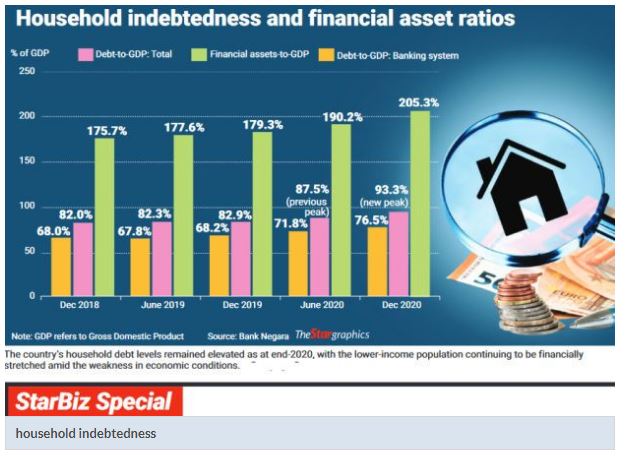Malaysia: Sustained income recovery crucial
PETALING JAYA: The country’s household debt levels remain elevated as at end-2020, with the lower-income population continuing to be financially stretched amid the weakness in economic conditions.
In its Financial Stability Review for the second half of 2020, Bank Negara said borrowers earning less than RM3,000 monthly faced low financial buffers and substantially higher leverage.
“Borrowers earning less than RM5,000 monthly also appear to be showing some signs of financial stress as observed from the profile of households seeking repayment assistance.
“These borrowers are likely to face continued challenges in 2021, given an uneven recovery in the labour market.
“Repayment assistance programmes by banks and government relief measures continued to provide support to households in distress, easing their cashflow constraints as they recover from income shocks and staving off more severe damage to both the financial system and the economy, ” according to the central bank.
Bank Negara highlighted the need for a sustained recovery in income among the lower-income population to maintain their debt-servicing capacity over the longer term.
“Outside this segment of household borrowers, most households are in reasonably good shape, with repayment levels by households in the banking system reaching over 90% of levels seen prior to the automatic loan moratorium.
“Debt-servicing capacity of most households has been sustained, supported by existing financial buffers and relief measures, ” it added.
The Financial Stability Review report, which was released yesterday, pointed out that the growth of household debt in the second half of 2020 has normalised to pre-Covid-19 levels as the country emerged from stringent movement control restrictions.
It also said that on aggregate, the household debt-to-gross domestic product (GDP) ratio rose to 93.3% as at end-2020, marking a new peak.
However, the increase in debt-to-GDP ratio was mainly due to the fact that the GDP remained below pre-crisis levels.
Despite the higher household indebtedness, the growth in households’ financial assets has continued to exceed the increase in debt levels in the second half of 2020.
Financial assets grew by 7.3% in the six-month period, while household debt grew by 5.5%.
This was driven by sustained deposit growth and a recovery in unit trust and equity holdings
According to Bank Negara, this indicated that in aggregate, households have managed to increase their financial wealth during the period.
As at end-2020, the financial assets-to-GDP ratio stood at 2.2 times, similar to the level seen in June last year.
Households held RM2.91 trillion in financial assets as compared to RM1.32 trillion in debt.
Meanwhile, the liquid financial assets-to-GDP ratio rose marginally to 1.5 times by December as compared to 1.4 times in June 2020.
Source: https://www.thestar.com.my/business/business-news/2021/04/01/sustained-income-recovery-crucial


 Thailand
Thailand





